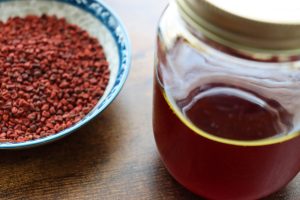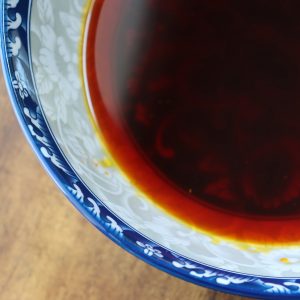Annatto Oil (Dầu Điều)

Annatto oil is a natural food colouring made from the seeds of the annatto plant (Bixa orellana), which is native to tropical regions. This oil has been used for centuries, especially in Latin American, Caribbean, and Southeast Asian cuisines, to impart a vibrant red or orange hue to dishes. It’s a popular alternative to synthetic food dyes, offering both a natural colour and a subtle, earthy flavour.
In cooking, annatto oil is typically used to enhance the visual appeal of foods like rice, soups, stews, and meats. The rich colour it adds can vary from a golden yellow to a deep reddish-orange, depending on the concentration and how long the seeds are heated in oil. In Filipino cuisine, it’s often used in dishes like lechon kawali (crispy fried pork belly) and kare-kare (a peanut-based oxtail stew). In Latin American cuisine, it’s commonly found in the preparation of arroz con pollo (chicken and rice) and tamales.
Apart from its colouring properties, annatto oil offers a mild, peppery taste with hints of nutmeg and floral undertones. This makes it ideal for recipes where a subtle depth of flavour is needed without overpowering the dish. It’s also a great option for those looking to avoid artificial additives, making it popular in natural or health-conscious cooking.
Since annatto seeds are naturally rich in antioxidants, using annatto oil as a colouring agent provides an added nutritional benefit, though in small amounts. Annatto oil is easy to prepare at home and can be stored for extended periods, making it a versatile and convenient ingredient in any kitchen.
Q&As on Annatto Oil

1. What are some of the health benefits of annatto oil?
Annatto oil, derived from the seeds of the annatto plant, offers several potential health benefits due to its rich content of antioxidants, vitamins, and natural compounds. Some of the notable health benefits include:
Rich in Antioxidants: Annatto seeds contain powerful antioxidants such as tocotrienols, a form of vitamin E, which help protect cells from oxidative stress and reduce inflammation. These antioxidants may contribute to improved heart health and a lower risk of chronic diseases.
Supports Skin Health: The high content of carotenoids in annatto oil, particularly bixin, may promote healthy skin by protecting against UV damage and supporting wound healing. It is also traditionally used in topical applications for its soothing properties.
Promotes Eye Health: The carotenoids in annatto, similar to those found in carrots, are beneficial for maintaining good vision and may help prevent age-related eye conditions like cataracts and macular degeneration.
Anti-Inflammatory Properties: Annatto oil is believed to have anti-inflammatory effects, which could be helpful in managing conditions like arthritis or inflammatory skin disorders when consumed as part of a balanced diet.
Potential for Cholesterol Management: Some studies suggest that tocotrienols in annatto oil may help lower LDL (bad) cholesterol levels, improving overall cardiovascular health.
While annatto oil is primarily used for its natural colouring and flavour, these health benefits make it an appealing ingredient for those looking to incorporate more natural and nutritious components into their diet. However, as with any food, it should be used in moderation as part of a balanced and healthy lifestyle.
2. Are there any side effects of using annatto oil?
Annatto oil is generally considered safe for most people when used in cooking. However, some individuals may experience allergic reactions, particularly if they have sensitivities to seeds or natural colourants. Symptoms of an allergic reaction can include itching, swelling, or hives, and in rare cases, more severe reactions like difficulty breathing.
Additionally, if consumed in very large amounts, annatto may cause mild gastrointestinal discomfort, such as nausea or an upset stomach. These side effects are uncommon, and most people can use annatto oil without any issues when incorporated as part of a balanced diet. If you have concerns or known allergies, it’s best to consult with a healthcare professional before using it.
3. Why should I add garlic when making annatto oil?
Adding garlic when making annatto oil enhances the flavour, giving the oil a subtle savoury and aromatic quality. While annatto oil is mainly used for its natural colouring, the infusion of garlic adds depth and richness, making it more versatile in cooking. The mild garlic flavour complements a variety of dishes, from stews to stir-fries, and adds a layer of complexity without overpowering the dish. Additionally, garlic has its own health benefits, such as anti-inflammatory and antimicrobial properties, which can add extra value to the oil.

4. I just made my annatto oil. How should I store it, and how long will it keep?
After making your annatto oil, allow it to cool completely before transferring it to a clean, airtight glass jar or bottle. Store the jar in a cool, dark place like your pantry, away from direct sunlight and heat sources, to help preserve its colour and flavour.
Annatto oil typically lasts for up to 3 months when stored properly. However, if you notice any off smells or changes in appearance, it’s best to discard it and make a fresh batch. Always ensure the container is sealed tightly after each use to prevent oxidation and extend its shelf life.
5. I’ve run out of annatto oil. What can I use as a substitute?
If you’ve run out of annatto oil, there are a few suitable substitutes depending on your recipe. For colour, paprika or turmeric can be used to provide a similar reddish-orange or golden hue, though they will impart their own distinct flavours.
For the mild flavour and cooking oil component, you can use regular vegetable oil or olive oil, but keep in mind that they won’t give the same vibrant colour. If both colour and a hint of flavour are important, try using a combination of paprika or turmeric mixed into a neutral oil. Each substitute will affect the final dish slightly differently, so choose based on whether colour, flavour, or both are important for your recipe.

How to Make Annatto Oil
Equipment
- 1 medium nonstick skillet
Ingredients
- 50 grams annatto seeds
- 300 mL cooking oil
- 2 garlic cloves, slightly crushed
Instructions
- Place the annatto seeds in a medium nonstick skillet and add 200 mL of cooking oil.
- Turn the heat to medium and stir continuously. Avoid using high heat, as this can cause the seeds to burn and the oil to darken.
- Once the oil begins to bubble, lower the heat and continue stirring for an additional 3 minutes.
- Remove the skillet from the heat and strain the oil into a bowl.
- Return the skillet to the stove, add back the seeds and then the remaining 100 mL of oil, and heat over medium-low. Stir gently.
- When the oil starts to bubble again, reduce the heat and stir for another 3 minutes. Add the garlic at this stage.
- Remove the skillet from the heat and strain the oil into the same bowl as the first batch.
- Allow the oil to cool completely, then transfer it to a glass jar for storage. Your annatto oil is now ready for use.

